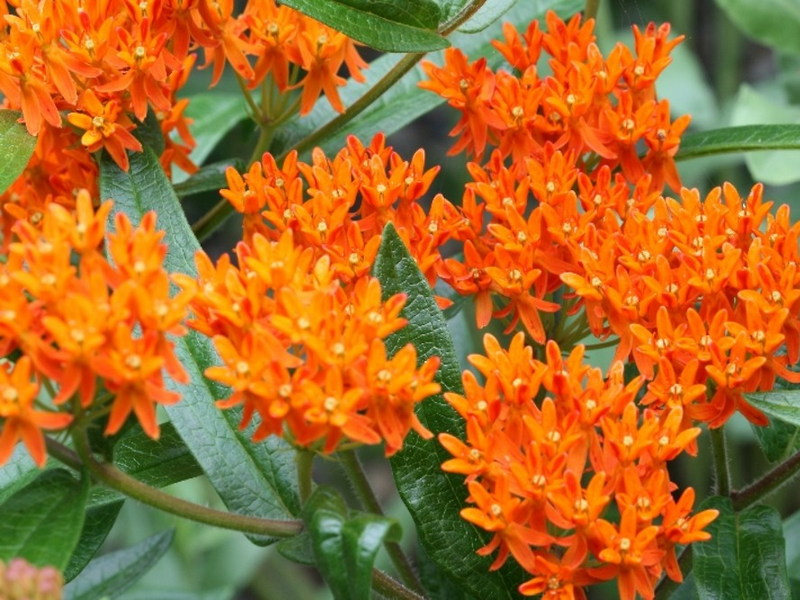Butterfly Weed
Asclepias tuberosa
Click here to download a PDF of this plant information page (for printing).

Sun Exposure: Sun, Part Sun
Season of Interest: Summer, Fall
Bloom Time: May - August
Bloom Color: Orange
Height: 12 to 24 in.
Spread: 12 to 16 in.
Spacing: 16 in.
Water Needs: Average
Maintenance: Very little
Soil Type: Clay, Loam, Sandy Rocky
Soil pH: Acidic, Neutral
Soil Drainage: Well drained
Pests: Aphids
Diseases: Leaf spot
Wildlife: Bees, Buterflies

Description:
Beloved for its ability to attract a variety of helpful (and beautiful) insects to the garden, butterfly weed is an easy-to-nurture herbaceous perennial that can also be found growing as a native wildflower in countless untamed environments, such as meadows, prairies, and forest clearings. It's a must-have plant for gardeners looking to coax the namesake winged insects into the garden. This clump-forming perennial grows from tuberous roots to a height of one to two feet and is characterized by glossy-green, lance-shaped leaves and clusters of bright orange-to-yellow blooms that are rich with nectar and pollen.
A type of milkweed, butterfly weed is fairly slow to become established. It does not bloom the first year from seed; in fact, it may take as long as three years before it flowers. When it finally does flower, its clusters of bright orange-yellow flowers will display from late spring until late summer for about two months. Butterfly weed is considered mildly toxic to animals. But because it has much lower levels of the toxic sap found in standard milkweed, butterfly weed is regarded as a safer plant in homes with pets.
Monarch butterfly caterpillars feed exclusively on the leaves of milkweed, the only host plant for this iconic species. As such, milkweed is critical for the survival of monarchs. Without it, they cannot complete their life cycle and their populations decline. Eradication of milkweed both in agricultural areas as well as in urban and suburban landscapes is one of the primary reasons that monarchs are in decline today. For more information see:
plants.ces.ncsu.edu/plants/asclepias-tuberosa
Care and Growing Tips:
If possible, choose a spot in your garden with lots of bright sunlight daily, full sun is definitely best for flowering. Butterfly weed can prosper in a variety of soil conditions and compositions, from sand to gravel, and it generally prefers a neutral to slightly acidic pH. For the first 6 weeks after transplanting you should maintain a moist soil environment for butterflyweed, giving it about one inch of water per week through combined rainfall and irrigation. Once the plant appears to be well-established, you can cut back to watering it only occasionally, as it now prefers dry soil. An extensive, deep taproot helps it thrive even in dry conditions. Mature plants can do well with just monthly watering in all but the driest climates.
Butterfly weed thrives in a variety of different temperature and humidity settings, growing well in zones 3 to 9. Generally, the plant emerges in late spring, hitting its peak bloom during the warmer summer months and drying on the stem throughout the autumn and winter. It handles high humidity and arid climates equally well, provided it gets adequate soil moisture. It is a low-maintenance plant that does not require any additional fertilization. In fact, doing so can harm the plant, making it excessively leggy and reducing blooms.